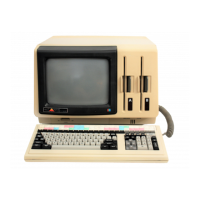Command Setup and Execution Under CPIM-86
The
8080 Model
supports
programs
which are directly translated from
CP
IM-80
when code
and
data
areas are intermixed. The 8080 model consists
of
one
group
which contains all the code, data,
and
stack areas. Segment registers are initialized
to
the starting address
of
the region containing this group. The segment registers
can, however, be managed by the application
program
during execution so
that
multiple segments within the code group can be addressed.
The
Small Model
is
similar
to
that
defined by Intel, where the
program
consists
of
independent code
and
data
groups. The Small Model
is
suitable for use by programs
taken
from
CP
IM-80
where code
and
data
are easily separated. The code
and
data
groups often consist of,
but
are
not
restricted to, single 64K byte segments.
The
Compact Model occurs when any
of
the extra, stack,
or
auxiliary groups is
present in a
program.
Each
group may consist
of
one
or
more segments,
but
if
any
group exceeds one segment in size,
or
if
auxiliary groups are present, then the
application
program
must
manage its own segment registers during execution in
order
to
address all code
and
data
areas.
In
all three models, local stacks are required in user programs
that
make BDOS calls
since the BDOS may change information in the system stack.
The
three models differ primarily in the
manner
in which segment registers
are~
initialized
upon
transient
program
loading. The operating system
program
load
function determines the memory model used by a transient
program
by examining
the
program
group usage, as described in the following sections
of
this chapter.
The 8080 Memory Model
The 8080 Model
is
assumed when the transient
program
contains only a code group.
In
this case, the CS,
DS,
and
ES registers are initialized
to
the beginning
of
the code
group, while the
SS
and
SP
registers remain set to a 96-byte stack area in the CCP.
The Instruction
Pointer
Register (IP) is set to 100H, as in
CP
IM-80,
thus allowing
base page values
at
the beginning
of
the code group. Following
program
load, the
8080 Model appears as shown in Figure 2-1, where low addresses are
at
the
top
of
the diagram.
2-3

